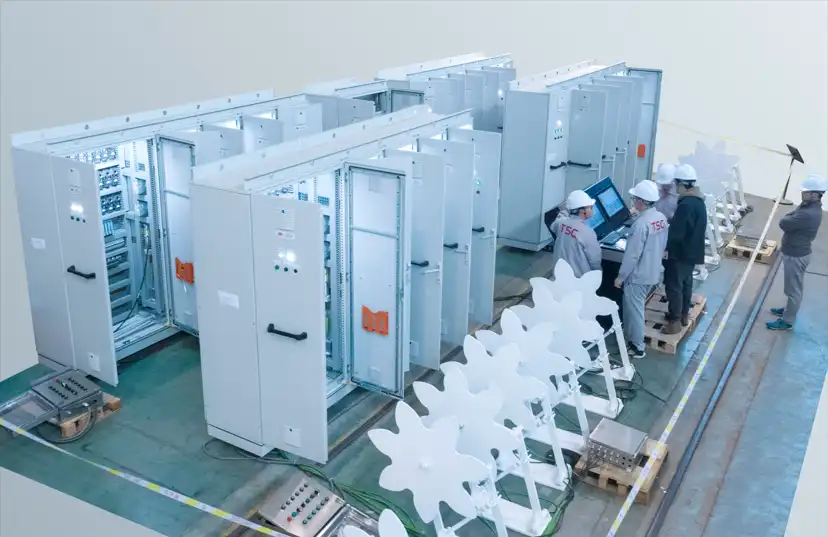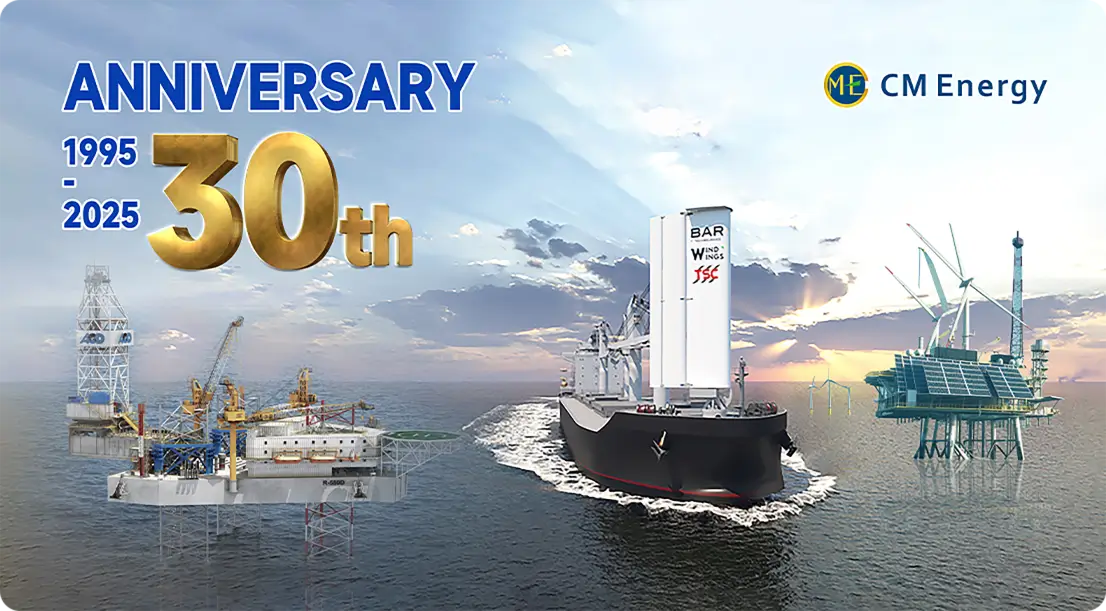TSC's jacking control system products are widely applied in various offshore structures, including self-elevating drilling platforms, wind power installation vessels, and liftboats. These systems employ state-of-the-art technology to ensure precise control and monitoring of leg height and jacking status, enabling operators to make informed decisions and maintain platform stability in challenging offshore environments.

Real-time data acquisition for leg position and load
Real-time data acquisition is the foundation of effective leg height and jacking status monitoring. The offshore platform jacking control system utilizes advanced sensors and measurement devices to collect critical information about the platform's legs and overall structure.
Leg Position Monitoring
Accurate leg position monitoring is essential for maintaining the platform's stability and ensuring safe operations. The jacking control system employs various methods to track leg position in real time:
- Rotary position sensors: These devices measure the rotation of the jacking system's gears or pulleys, providing precise information about leg movement and position.
- Linear position sensors: Installed along the leg structure, these sensors directly measure the leg's vertical position relative to the platform's hull.
- Laser distance meters: High-precision laser devices can be used to measure the distance between the platform's deck and the seabed, offering an additional reference for leg position.
Load Monitoring
Continuous monitoring of leg loads is crucial for preventing overloading and ensuring even weight distribution across the platform. The jacking control system incorporates load monitoring through:
- Strain gauges: These sensors measure the deformation of structural components under load, providing real-time data on the forces acting on each leg.
- Load cells: Installed at strategic points in the jacking system, load cells directly measure the weight supported by each leg.
- Pressure sensors: In hydraulic jacking systems, pressure sensors monitor the hydraulic pressure in the jacking cylinders, which correlates with the load on each leg.
What sensors are used for jacking system monitoring?
The offshore platform jacking control system relies on a variety of sensors to gather comprehensive data about the platform's status and performance. These sensors work in concert to provide a complete picture of the jacking operation and platform stability.
Primary Jacking System Sensors
The following sensors form the core of the jacking system monitoring setup:
- Inclinometers: These devices measure the platform's tilt or inclination, ensuring the structure remains level during jacking operations.
- Accelerometers: Used to detect vibrations and sudden movements, accelerometers help identify potential issues or instabilities in the jacking process.
- Temperature sensors: Monitoring the temperature of critical components helps prevent overheating and ensures optimal system performance.
- Proximity sensors: These devices detect the position of moving parts within the jacking system, such as pinions or gears, to ensure proper engagement and operation.
Environmental Sensors
In addition to the sensors directly related to the jacking system, environmental sensors play a crucial role in monitoring external factors that can affect platform stability:
- Wind speed and direction sensors: These devices provide real-time data on wind conditions, which can impact platform stability and jacking operations.
- Wave height and period sensors: Monitoring sea state helps operators make informed decisions about when to initiate or pause jacking operations.
- Current meters: These sensors measure water currents around the platform, which can affect leg loads and overall stability.
The importance of continuous feedback in jacking control
Continuous feedback is a critical aspect of the offshore platform jacking control system, ensuring safe and efficient operations throughout the jacking process. This real-time information flow allows operators to make informed decisions and respond quickly to changing conditions.
Real-time Monitoring and Visualization
The jacking control system processes data from various sensors and presents it in an easily understandable format through a human-machine interface (HMI). This real-time visualization typically includes:
- Leg height displays: Showing the current position of each leg relative to the platform and seabed.
- Load distribution graphs: Visualizing the weight distribution across all legs to ensure even loading.
- Inclination indicators: Displaying the platform's current tilt and any deviations from the desired level position.
- Alarm systems: Providing visual and auditory alerts when predefined thresholds are exceeded or potential issues are detected.
Adaptive Control Algorithms
Advanced jacking control systems utilize adaptive control algorithms that continuously adjust the jacking process based on real-time feedback. These algorithms consider factors such as:
- Leg load balancing: Automatically adjusting individual leg movements to maintain even weight distribution.
- Inclination correction: Fine-tuning leg positions to keep the platform level during jacking operations.
- Environmental compensation: Adapting the jacking strategy based on current wind, wave, and current conditions.
By incorporating continuous feedback and adaptive control, the jacking system can maintain optimal performance and safety throughout the operation, even in challenging offshore environments.
Conclusion
Real-time monitoring of leg height and jacking status is essential for the safe and efficient operation of offshore platforms. The offshore platform jacking control system integrates advanced sensors, data acquisition technologies, and sophisticated control algorithms to provide operators with the information and tools needed to maintain platform stability and safety. By leveraging continuous feedback and adaptive control strategies, these systems ensure precise and reliable jacking operations in diverse offshore conditions.
As the offshore industry continues to evolve, the importance of accurate and reliable jacking control systems will only increase. Investing in advanced monitoring and control technologies is crucial for maximizing operational efficiency, enhancing safety, and extending the lifespan of offshore platforms.
For offshore operators seeking to optimize their platform performance and safety, TSC offers cutting-edge jacking control system solutions tailored to meet the unique challenges of the marine environment. With a proven track record of reliability and innovation, TSC's systems provide the precision and control needed to tackle even the most demanding offshore projects.
Ready to boost your offshore platform's performance and safety with state-of-the-art jacking control systems? Contact CM Energy now to learn how our unique solutions can transform your operations. Our team of specialists is standing by to give tailored guidance and assistance. Reach out to us at info.cn@cm-energy.com and take the first step towards optimizing your offshore platform's efficiency and reliability.
FAQ
1. How often should jacking system sensors be calibrated?
Sensor calibration frequency depends on various factors, including the specific sensor type, environmental conditions, and regulatory requirements. Generally, it's recommended to calibrate sensors at least annually or more frequently in harsh offshore environments.
2. Can jacking control systems be retrofitted to existing offshore platforms?
Yes, many modern jacking control systems can be retrofitted to existing platforms. However, the feasibility and complexity of the retrofit depend on the platform's age, current control system, and structural design. A thorough assessment by experienced engineers is necessary to determine the best approach for each specific case.
3. How do jacking control systems handle power failures?
Advanced jacking control systems typically incorporate redundant power supplies and uninterruptible power systems (UPS) to ensure continuous operation during power failures. Additionally, they often include emergency backup systems and fail-safe mechanisms to maintain platform stability in case of a complete power loss.
References
- Johnson, R. (2023). Advanced Monitoring Techniques for Offshore Platform Jacking Systems. Journal of Offshore Technology, 45(2), 78-92.
- Smith, A. & Brown, B. (2022). Real-time Data Acquisition in Offshore Environments: Challenges and Solutions. Marine Engineering Review, 33(4), 112-125.
- Lee, C. et al. (2023). Adaptive Control Algorithms for Offshore Platform Jacking Operations. IEEE Transactions on Control Systems Technology, 31(3), 890-903.
- Wilson, D. (2022). Sensor Technologies for Offshore Structure Monitoring. Offshore Technology Conference Proceedings, Houston, TX, USA.
- Garcia, M. & Taylor, P. (2023). Environmental Factors Affecting Offshore Platform Stability: A Comprehensive Review. Ocean Engineering, 217, 108232.
- Anderson, K. (2022). Safety Considerations in Offshore Platform Jacking Operations. International Journal of Maritime Engineering, 164(A3), 251-263.

